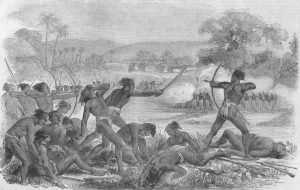Peasant revolts of the 18th and 19th centuries are a very important segment of the modern Indian history syllabus for the IAS exam. Santhal Rebellion is one such revolt against the oppression of Santhals (agricultural people) settled in Rajmahal Hills in Bihar.
The topic, ‘Santhal Rebellion’ is an important segment of Modern Indian History. This article will provide you with relevant details on Santhal revolt, helpful for civil services exam.
Who were the Santhals?

They were the agricultural people settled in Rajmahal Hills of Bihar. British turned to them for the expansion of the revenue through agriculture. Santhals agreed to clear forests to practice settled agriculture. In 1832, a large number of areas were demarcated as Damin-i-Koh or Santal Pargana. However, gradually the exploitation started from the British side and to such an extent, that it gave rise to Santhal Rebellion.
Read about the important facts about Santhals in the points below:
- The Santhals are the largest tribal group in India today as per the population figures. They are native to the Indian states of predominantly Jharkhand, West Bengal and Odisha.
- Until the 19th century, they lived their lives in harmony with nature and practised shifting agriculture and hunting. They lived in the hilly regions of Birbhum, Barabhum, Manbhum, Palamau and Chhotanagpur.
- These areas came under the Bengal Presidency whose rule passed onto the British after the Battle of Plassey in 1757. The Santhal life was disrupted by the onslaught of the Zamindari system that they introduced. They were rendered landless bonded labourers in their own homes.
- The local landlords occupied the Santhal lands and exploited them.
- The tribals engaged in commercial activity by the barter system. When currency was introduced because of the colonial intervention, they began to rely on the moneylenders. These moneylenders exploited them and reduced them to abject poverty. They were weighed down by heavy debts which kept mounting amidst the poverty and the humiliation of being landless in what was traditionally their turf.
- On 30th June 1855, two years before the Great Revolt of 1857, two Santhal brothers Sidhu and Kanhu Murmu organised 10,000 Santhals and proclaimed a rebellion against the British. The tribals took an oath to drive away from the British from their homeland. The Murmu brothers’ sisters Phulo and Jhano also played an active part in the rebellion.
- When the police came to arrest the brothers, the villagers killed the policemen. They were able to capture large parts of land including the Rajmahal Hills, Bhagalpur district and Birbhum.
- Although the rebellion took the government by surprise, they crushed it with a heavy hand. The British firepower was no match for the tribal methods of warfare composed of spears and arrows. About 15000 Santhal villagers including the Murmu brothers were killed and their villages destroyed.
- The landlords supported the government whereas the local people including the milkmen and the blacksmiths supported the Santhals.
- The Santhals were fierce fighters but they were honourable. According to some British observers of the time, the Santhals used poisoned arrows for hunting but did not use poisoned arrows against their enemies in war. It is ironical that the British came to ‘civilise’ the natives.
- Martial law was declared on 10th November 1855 and it lasted till 3rd January 1856.
- The British passed the Santhal Parganas Tenancy Act in 1876 which offered some protection for the tribals against exploitation.
- The Santhal rebellion was overshadowed by the revolt of 1857 but it remains a watershed in the evolution of the modern Santhali identity. It played an important role in the creation of the state of Jharkhand in 2000.
Santhal Rebellion – The Uprising of Santhals
The Santhal Revolt took place in 1855-56. Santhals are a tribal group concentrated in the state of Jharkhand. This was the first peasant revolt that occurred in India. The revolt can be attributed to the introduction of the Permanent Land Settlement of 1793.
The aforesaid settlement pattern by the British snatched lands that the Santhals had been cultivating for centuries from them. The zamindars, moneylenders, Europeans and the British government officials raised the land tax and exploited farmers. They were so oppressed that they resolved to rebel against the landlords and the government.
The Santhals engaged in guerrilla warfare. This was a new occurrence for Bihar. The Santhals formed their own armies composed of peasants marching against their oppressors. The Santhal army dismantled the railway and postal communications. Surely, the Santhal revolt was very effective for a while but it could not succeed against the absolute power of the government and was suppressed.
Facts about Santhal Rebellion for UPSC Prelims
| Santhal Rebellion | |
| Who were Santhals? | Agricultural People |
| What did Santhals Practise? | Originally, hunting, fishing were their occupation but later on with British’s involvement, they turned to settled agriculture |
| Where did Santhals reside? | Rajmahal Hills |
| When did the Santhal Rebellion start? | In 1855 |
| Who led the Santhal Rebellion? | Four Brothers – Sido, Kanhu, Chand and Bhairav |
Santhal Rebellion – UPSC History Notes:- Download PDF Here
Related Links:
Comments